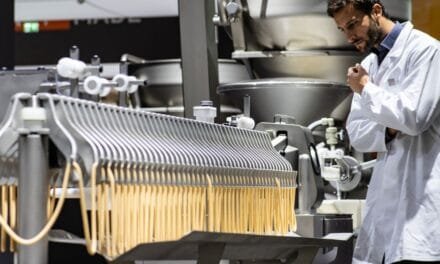The meaty rice grains are packed with beef muscle and fat cells, cultured in a laboratory, which the scientists believe could offer an affordable and eco-friendly source of protein.
The new grain was grown in a lab by researchers at Seoul’s Yonsei University and is packed with beef muscle and fat cells. The result is bright pink rice, reportedly slightly harder, less sticky, and more brittle than conventional rice. Rice with a higher muscle content had the scent of beef and almonds, while rice with a higher fat content had the scent of cream or coconut oil.
The researchers say the food may serve as “relief for famine, military ration, or even space food” in the future. They started by first coating rice grains with fish gelatin, providing a base for the cow muscle cells to stick to.

They then allowed the cells to grow throughout the rice grains, which took about 5-7 days before the rice was placed in a medium that encouraged the cow cells to multiply inside the grains.
The resulting ‘meaty rice’ hybrid can be boiled or steamed, as with normal rice. According to New Scientist Jinkee Hong, a researcher working on hybrid rice, said that its texture is “harder, more brittle and less sticky than regular rice, with a nutty taste.”
This study’s ultimate objective is to propose a new type of sustainable food ingredient that fuses rice grains and animal cells. Rice grains are predominantly composed of carbohydrates, but they also contain protein, fat, vitamins, and minerals.
“It’s not beef-like in the traditional sense but offers a new gastronomic experience that combines the familiarity of rice with the richness of meaty umami flavours,” he said.

Researcher Sohyeon Park commented: “Imagine obtaining all the nutrients we need from cell-cultured protein rice. Rice already has a high nutrient level, but adding cells from livestock can further boost it. I didn’t expect the cells to grow so well in the rice. Now I see a world of possibilities for this grain-based hybrid food.”
Unlike other kinds of cell-based meat, Hong said that the ingredients used in producing the ‘meaty rice’ are well-known, provide a high nutritional value, and are not expensive, with no genetic modification involved in the process.
Hybrid rice contains 7% more protein and 8% more fat than ordinary rice, with scientists estimating it to produce around 6kg of CO2 for every 100g of protein. At the same time, traditional beef releases about 50kg.
“These advantages…offer a way to produce meat in a more sustainable manner, reducing the environmental footprint associated with traditional livestock farming and offering a novel food source that could help meet the growing global demand for protein,” Hong concluded.
The findings of this study provide feasible ideas for creating various types of future hybrid foods. In the future, this self-production system of grain-based hybrid foods could ensure food relief in underdeveloped countries, during war, and in space.
‘Processed Food Industry’: The Voice of Food Processing Industry
Processed Food Industry (PFI) is a premier English-language monthly B2B publication (ISSN 09721649) headquartered in New Delhi, catering to the vibrant and ever-evolving food processing industry. While we don’t claim to be the largest or most widely read, our proud legacy of over 27 years—publishing continuously since 1997—has earned us the trust of industry professionals as a reliable source of insights and information.
If your goal is to tap into the booming Indian and South Asian markets to promote your equipment, technology, software, or consumables, PFI is your strategic partner. With our hybrid approach across print, web, and social media, we help you establish strong brand recognition rooted in market relevance. Backed by a team of top-tier technical writers, we’re ready to work closely with you and your customers to craft compelling content that drives results.
India and South Asia’s food industry is expanding rapidly, driven by efficiency and cutting-edge innovations. Don’t miss the opportunity to elevate your brand and engage with this dynamic market. Get our 2025 media kit to fine-tune your marketing strategy, increase your visibility, and convert potential customers into valuable conversations. Additionally, ask for a sample copy of our monthly magazine and experience the quality and relevance we deliver.
Let us help you define your role in the future of the food processing industry.

Have a news or topic to share with industry? Write to us editorial@pfionline.com
















